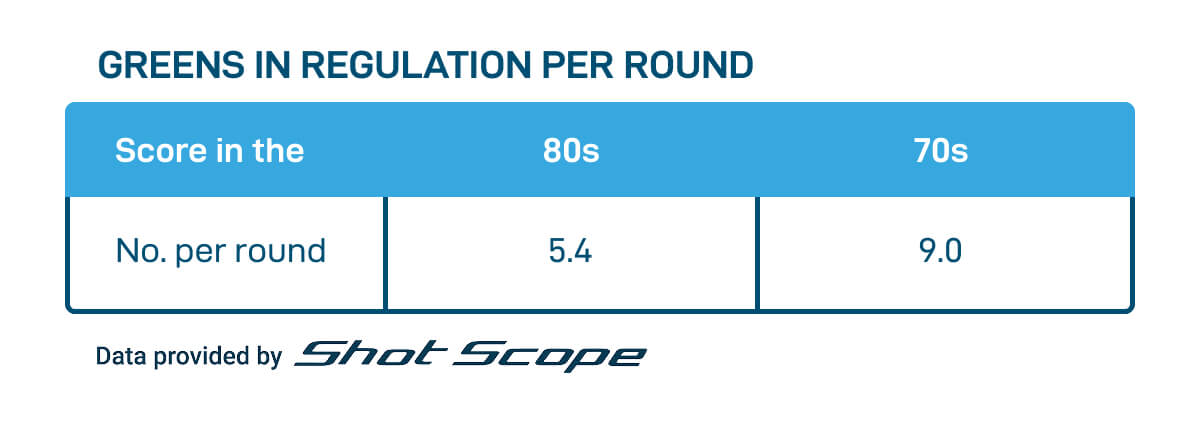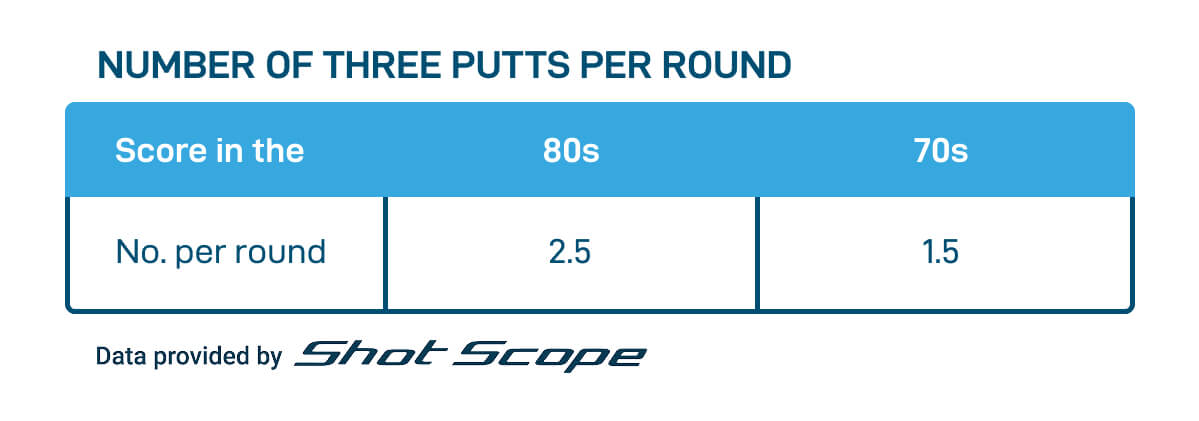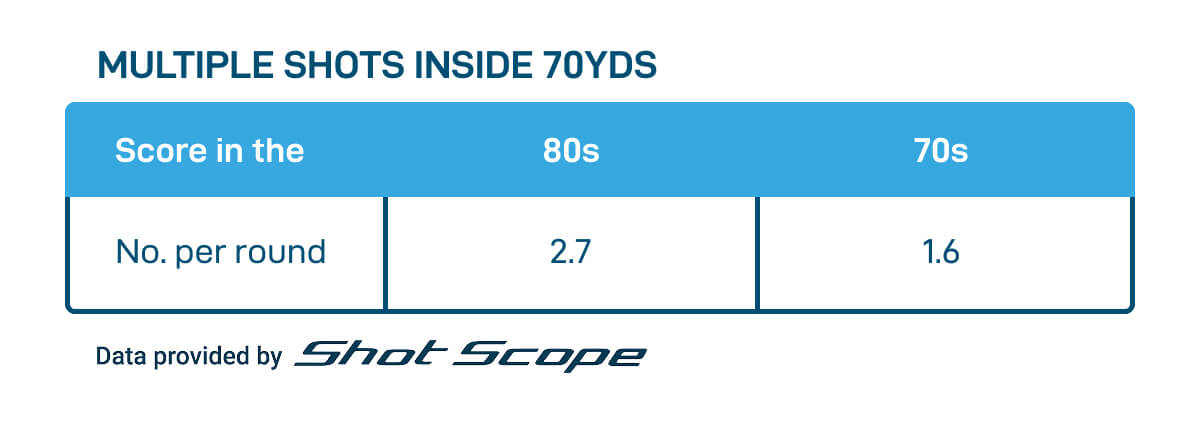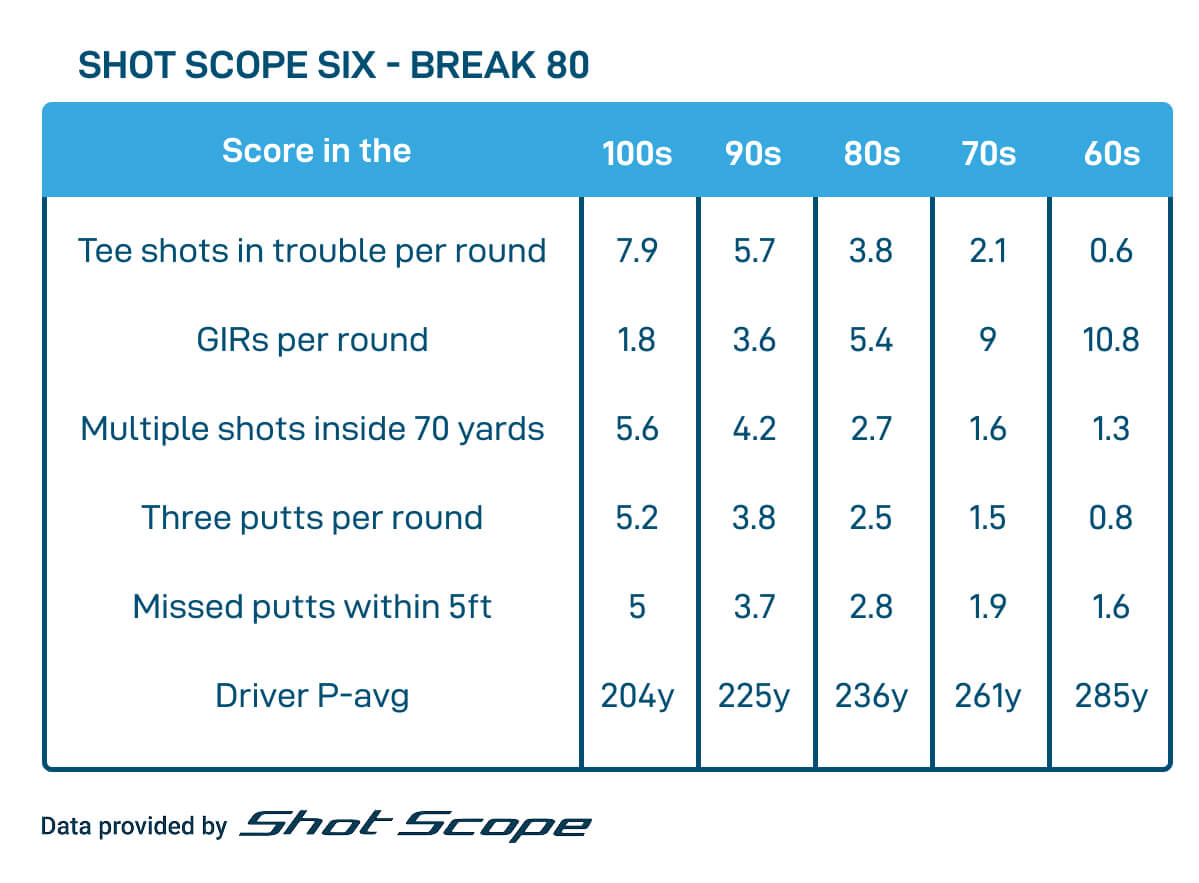Breaking 80 is one of those mythical scoring barriers that sits somewhere between “totally achievable” and, “yeah, maybe in your dreams, buddy.” It’s golf’s version of finally getting that promotion you’ve been chasing—close enough to taste but somehow always just out of reach.
To help you crack this code, we asked the data nerds at Shot Scope to crunch the numbers on what actually separates the 80s shooters from the 70s club.
Spoiler alert: It’s not magic. It’s not even talent, really. It’s just doing a few things consistently less terrible than you’re currently doing them.
Through their analysis of millions of rounds (yes, millions—apparently a lot of people are tracking their disappointment), they’ve identified six key areas that separate an 80s shooter from someone who gets to put a 7 at the front of their score.
The Shot Scope Six
- Number of tee shots in trouble
- Greens in regulation (GIR)
- Multiple shots inside 70 yards to hit the green
- Number of three-putts
- Missed putts inside five feet
- Driving distance
Let’s dive into the three most impactful stats to help you consistently break 80. We’ll get to the other three later but, honestly, fix these three and you’re most of the way there.
Key stat No. 1: Greens in regulation

If you want to start seeing your score begin with a 7, hitting more greens isn’t optional. It’s mandatory. Non-negotiable. The price of admission.
Golfers who consistently shoot in the 70s typically hit nine greens in regulation per round, nearly double that of someone still stuck in the 80s (who averages just five).

Statistically speaking—based on the Shot Scope Six—this is the single biggest difference between a player who shoots in the 80s and one who shoots in the 70s.
Here’s the thing: By hitting more greens, you reduce the number of times you have to attempt a tricky up-and-down. And, let’s be honest, for most of us, that’s about as reliable as your buddy who says he’ll “definitely make the 7 a.m. tee time.”
The math is brutal but simple. The golfer who shoots in the 80s fails to get up and down 60 percent of the time. That means if you miss six greens, you’re dropping at least three strokes just trying to salvage par. Miss nine greens? You’re basically donating four or five shots to the golf gods for no good reason.
The fix is almost embarrassingly simple: Aim for the middle of the green rather than attacking pins. I know, I know—it’s not sexy. It won’t give you a story for the 19th hole. But it works.
Stop playing like you’re Scottie Scheffler in the final round of the Masters. You’re not. You’re a guy trying to break 80. Act like it.
Knowing your club distances and choosing the right club are paramount here. If you’re still guessing whether it’s a hard 8-iron or a smooth 7, you’ve already lost.
Key stat No. 2: Three-putts

Once you’ve safely navigated your way onto the green (congratulations on doing the bare minimum), the next goal is simple: Don’t three-putt.
For golfers scoring in the 80s, 2.5 three-putts per round is the norm. That means two or three per round, typically. The good news? To break 80, you simply need to have one less per round. Just one.

That’s it. One less three-putt could be the difference between 79 and 80.
The biggest culprit for three-putts is often poor lag putting—leaving your first putt somewhere between “that’s makeable” and “well, at least it’s not off the green.” From long distance (20 feet and beyond), anything inside three feet is good. If it’s past the hole, even better.
Shot Scope data tells us that from inside three feet, even a 25-handicap golfer holes nine of 10 putts (88 percent). So, if you can just get your lag putting dialed in enough to leave yourself these gimmes, you’ll dramatically reduce your three-putt frequency.
Think of it this way: Three-putts are golf’s equivalent of unforced errors in tennis. They’re almost completely avoidable, utterly frustrating, and they make you look like you don’t know what you’re doing.
Stop giving away strokes. Your scorecard will thank you.
Key stat No. 3: Multiple shots inside 70 yards to hit the green

Despite what your ego tells you, you’re not as good from inside 70 yards as you think you are.
I know you want to nestle that wedge shot a few feet from the hole. We all do. But here’s a reality check: Golfers shooting in the 80s average 2.7 instances per round where they take multiple shots from inside 70 yards just to hit the green.

Not get it close. Not make birdie. Just to get the ball on the putting surface.
For those breaking 80, this number drops to just 1.6. That’s a saving of more than one full stroke per round just by hitting the green from short range, regardless of how close you get it.
Let that sink in. You could shave a full stroke off your score by simply not chunking, blading or otherwise butchering shots from pitch-and-chip distance.
The solution? Lower your expectations. Prioritize getting the ball on the green with your first attempt, even if it’s nowhere near a tap-in. A two-putt from 30 feet is always better than a duffed chip followed by another chip and two putts.
Sometimes boring golf is winning golf. Embrace it.
The complete picture
To show you the progression through the scoring barriers, here’s the Shot Scope Six benchmark data.

The bottom line
In summary, to break 80 consistently, you should aim to:
- Hit at least nine greens in regulation (double what you’re probably hitting now).
- Have fewer than two three-putts per round (one less than your current average).
- No more than two holes where multiple shots are needed to hit the green inside 70 yards (because chunking wedges is embarrassing).
While these three stats are the heavy hitters, improving across all of the Shot Scope Six metrics will undoubtedly help you achieve your goal.
The beauty of breaking 80 isn’t that it requires you to become a scratch golfer. It just requires you to stop making dumb mistakes.
Hit more greens. Don’t three-putt. Don’t chunk wedges.
Do those three things and you’ll be signing scorecards with a 7 in front before you know it.
If you’re looking for a seamless, subscription-free way to track these stats and more than 100 other tour-level metrics, check out Shot Scope’s performance tracking products. They offer GPS watches, rangefinders and more to help you get the most out of your game.
Now stop reading and go practice your lag putting.
The post How To Break 80 With The Shot Scope Six appeared first on MyGolfSpy.


